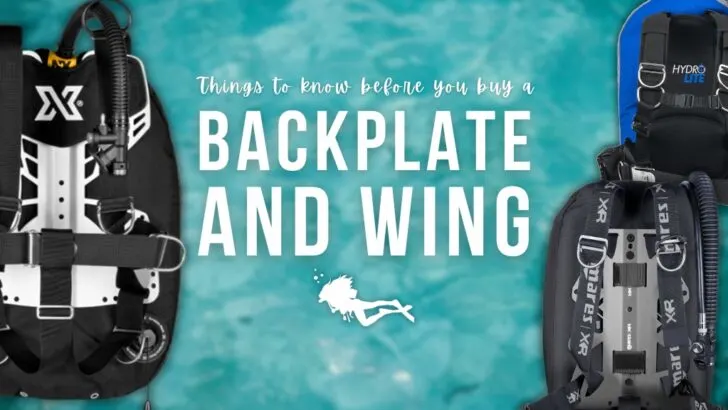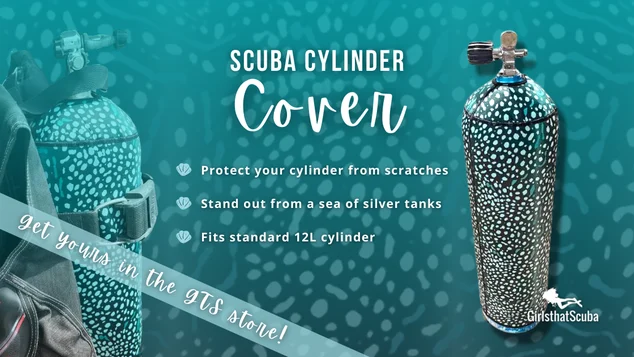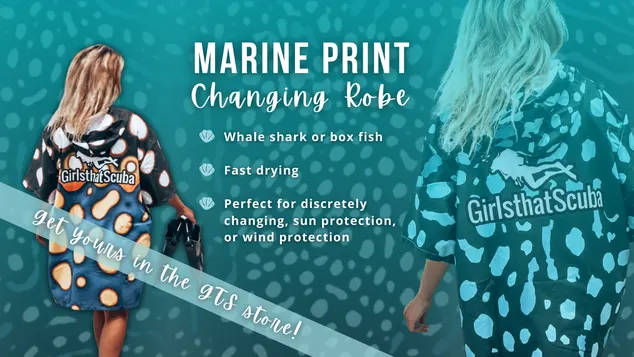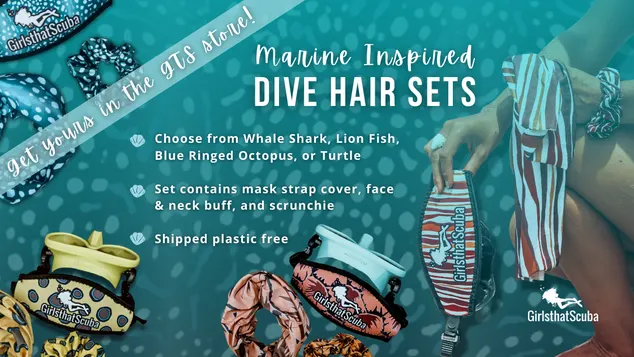Girls that Scuba member Emma Hughes, an avid UK diver, tells us about her experience buying her first backplate and wing. Read on for her account of the learning curve of this equipment decision!
Like most divers I started diving with a jacket style BCD, and as that’s what I’d learnt to dive in. After a while, I decided to purchase my own.
After a couple of years of diving, and no end of people telling me I’d love a backplate and wing system (BPW), I decided to take the plunge and buy myself my own set up. Here are the mistakes I made and things I wish I knew. I’ll also share what I love, and don’t love so much, about the backplate systems.
What is a backplate and wing system?
A backplate and wing set up breaks down into three parts:
1. Backplate
Normally made of metal – either stainless steel or aluminium. You can also get titanium or carbon fibre backplates, although these are less common.
2. Harness
This is the webbing or straps which hold the system to you. There are various options in terms of flexibility, colour, and whether it’s a continuous piece of webbing or multiple pieces with clips for easy adjustment.
3. Bladder (Wing)
The bladder is the part which gives you buoyancy. There are different sizes and shapes, including single cylinder or twin cylinder bladders.
Where and how do I buy a backplate BCD?
As a first time buyer, it is a total minefield trying to figure out what to choose! There are so many options and it can be very overwhelming. The main advice I can give is to go your local dive shop and talk to them in depth.
If there’s an Instructor or Divemaster you’ve dived with previously that knows you and your diving style, quiz them. Have a look at what the dive shop have in stock, and if you can try one on have a go at adjusting it. Even better, if the shop has rental wings, go for a dive and try one out.
Theoretically you can choose elements from different manufacturers, buy them separately, and build your own custom set up.
There are some issues with certain manufacturers only working or mixing with their own equipment, but generally you can mix and match. Personally I found it less daunting to buy a complete kit from one manufacturer.
Which BPW system did I choose?
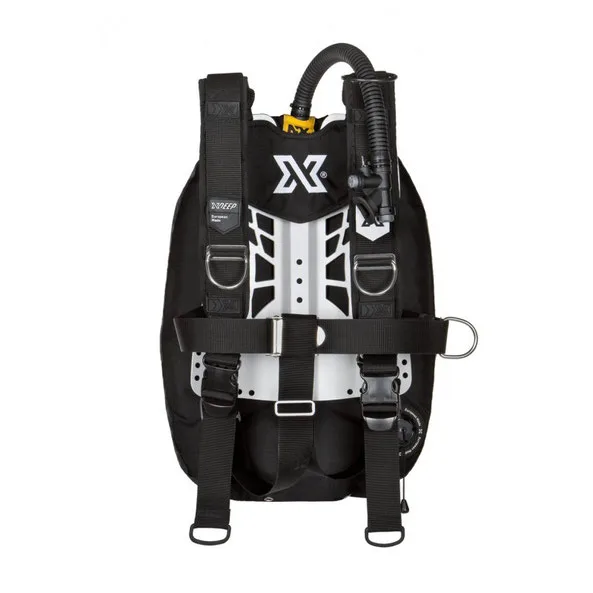
I went for an X-Deep NX Zen Deluxe set up. When researching, the one manufacturer that comes up when discussing BPW set ups the most is X-Deep. As X-Deep specialise in backplate systems and sidemount set ups, it seemed to make sense.
It was a close call between X-Deep and Apeks – I am very much an Apeks girl. However, the thing that pushed X-Deep over the line is their Tune Up custom gear creator.
This is a system they have which allows you to choose your system, then to customise it to your size and preference. You can choose backplate size, harness length, colour, whether you want padding, and many other options. Adjusting the length of your inflator corrugated hose is a helpful option!
You can even customise the wings with your own name or logo so it’s a very cool system. Bear in mind though this all comes at a price – it’s not cheap!
Once you’ve designed your set up you get a summary sheet with your options. This has a unique number, and you take this to your nearest X-Deep distributor to get it ordered. If you’re lucky, your dive shop might give you a bit of a discount on the price!
How to adjust a backplate harness
I’m not sure what I imagined when I got my set up out of the box and tried it on the first time, but I certainly didn’t think I’d need to adjust it as much as I did. The first major thing when you change to a BPW – don’t think you can just get it out of the box and go diving!
It takes a LOT of adjustment to get the harness fitted to you. If your experience is anything like mine, it will involve a lot of swearing and red raw painful fingers. It’s not just the harness – you’ll want to move all the D-rings to where you need them. You may even need to add additional D-rings.
Maybe you want to add a chest strap, or perhaps add some trim weight pockets? Whatever you do, make sure you take some time getting to know the gear and getting things how you like it.
It involves a lot of trying on, taking it off again, and making lots of minor adjustments. However, it’s worth it because they make a big difference to the fit and your comfort.
Diving with my new backplate and wing


My first dive with my new setup was in one of my dive club pool sessions. I’m very lucky to be part of a great dive club (Aquanauts in Plymouth) that offer regular pool sessions. These are a great opportunity to test out new gear. I really recommend doing this for all new gear if you can.
Luckily I made the last pool session on the same evening the nationwide lockdown was announced, just before all the pools had to shut the following day. I spent a while sat by myself putting my gear together, checking it all thoroughly, then got in for my first try.
I had no idea how much weight I would need to get down, but with my stainless steel backplate (around 3kg) I didn’t need any lead to descend. Then I spent the next 40 minutes pottering around by myself just getting used to being underwater with it.
Although it was clear I had some further adjustments to make, it felt really easy and stable to dive with.
First Ocean Dive
Fast forward just under two and half months of lockdown, I finally got to do my first sea dive with the new kit. This was also my first sea dive in about 7 months. I was definitely feeling apprehensive for how it was going to go.
My dive buddy and I met to go for a shallow shore dive. I had some new regulators and a new DSMB I wanted to try out on this dive too, so there was a lot going on. In retrospect, I had too much going on. I didn’t know what weight I’d need so I went for more than enough!
The dive went pretty well, apart from a couple of issues with my buoyancy while focusing on my DSMB. My second dive a couple of weeks later also went fine. I dropped some lead, but I did feel a bit unstable at some points and felt like I was going to get pulled on to my back.
I hadn’t experienced the issue some divers I’d read about had encountered. Some mentioned that on the surface the wing pushed them forward. On the surface while floating I felt fine and stable.
Backplate and wing problems
My third dive was where I had my first real issue. This was another shore dive, but this time there was quite a surge and it looked a bit choppy. With my weight set up, along with the steel backplate and 15l cylinder, I had the rest of my lead in trim pockets attached to my cam band.
This meant I had all my weight on my back, which in my head was a good thing as it would help with my trim in the water. Walking on the surface with all this weight on my back was extremely hard, so I wanted to get straight in the water as soon as possible to get the weight off.
With my urgency to get in the water and with the sea surge, I lost my footing on some rocks in the shallows and fell to the side. As I did, I could not get myself back up. With all the weight on my back I was being pulled on to my back and ended up “turtling” and unable to get back up!
I didn’t have my mask or fins on at this point, and in my attempts to right myself I dropped them (luckily my buddy grabbed them), and as I didn’t have a mask on and the waves were washing over my face, I started to panic.
My buddy came over and eventually all was sorted, but my confidence was definitely dented. We did the dive (with the most horrendous visibility) but I spent the whole time being annoyed with myself for losing control and making an idiot out myself. For the first time in my scuba life, I was glad the dive was over.
Loose Wing
Fast forward a couple more dives and all felt like it was going well. Then… well… this happened.
It was my second dive on the boat, I was all kitted up and raring to go. I jumped in off the boat and… well, I didn’t quite know what happened. Something was definitely wrong, but I couldn’t figure out what had happened.
I could see my wing over my shoulder, and I figured maybe one of my cam bands had come undone. The boat came back around, picked me and my buddy back up, and it turned out my wing had detached from the backplate!
Check your bolts!
I was completely perplexed wondering how it had happened. On further inspection when the wing had detached it had ripped out my dump valve. The skipper and crew spent a frantic 20 minutes making some temporary repairs with spares on the boat so we could get in for the dive. By this point though I had made up my mind I didn’t want to go back in until I’d taken it home and thoroughly checked everything.
As I was sat chatting to the DM and the skipper they both said, “When did you last check your bolts?”. I looked at them and said, “Not since I’ve had it, I’ve only done a handful of dives”. The skipper snapped back “You need to check your bolts before every dive!”.
Not once since I’d had the wing had anyone said that to me. I had read my manual that came with my setup and it had said about checking bolts, but I’d obviously wrongly assumed that they wouldn’t have come loose after so few dives, especially loose enough to come clean off.
To me, that’s a safety thing that feels like it need to be more strongly pointed out to BPW newbies like me. I’ve since found out this happened to another club member with a new wing a month or so before it happened to me, so it must happen to a fair amount of new BPW divers before they learn the lesson like I did.
What I’ve learnt about backplate and wings
So was it worth the switch? I think it will be. Honestly, if PADI did a BPW speciality, I would have so signed up!
I’m sure there are people who start diving with a wing and it all goes smoothly straight away, but this is my experience. There are things I really wish I knew before getting the set up and certainly before diving with it, and I hope if you’re reading this and were considering the switch that it’s helped (like seriously, check those bolts before every dive).
Simplicity
I do currently miss the ease and comfort of my jacket BCD… it’s so easy adjusting all those straps before each dive and just jumping in. Also, pockets!
Storage and D-Rings
All those pockets you have in a jacket BCD you don’t get with a wing. I have a cargo pocket with my wing which is attached to my waistband, but as I don’t have any other pockets (thigh pockets etc) I’m definitely stuffing a lot in that single pocket.
Dump Valves
Also dump valves – you get so many in a jacket BCD but only two with the wing, and you have to be positioned in certain ways in the water to dump the air from them. Then there’s crotch straps – wow, if anyone has an easy way of grabbing them between your legs when you’re kitted up please tell me. At the moment I’m getting my buddy to fumble around grabbing it for me before each dive which is causing lots of amusement.
I’m going to persevere but it’s been a learning curve. I definitely assumed it would be an easier switch than it has been but I feel it will be worth it in the long run. I like to challenge myself and evolve my skills so this change has ticked both those boxes. The main advice I can give is to not let your confidence slip when you hit a hurdle with it.
Dive straight back in (literally!) with the lessons you’ve learned from what’s gone wrong and you’ll keep improving.
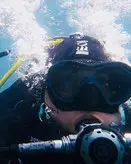
About the Author
Emma is an avid UK scuba diver and long time member of the Girls that Scuba community. Find her on Instagram @emmayhughes.

